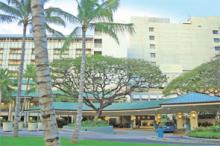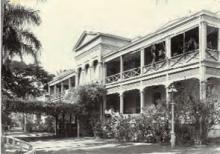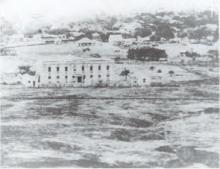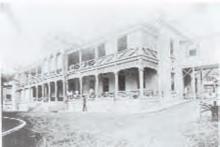User login
It may be isolated in the middle of the vast Pacific Ocean, but physicians and patients at The Queen’s Medical Center (QMC) in Honolulu, Hawaii, consider themselves anything but stranded.
The only hospital in the nation started by a monarchy, Queen’s is an example of the evolution of medicine and healthcare delivery—from the natural herbal remedies used by native Hawaiians to the world-class medical tools it employs today.
Founded in 1859 by Queen Emma and King Kamehameha IV, The Queen’s Hospital (as it was called at the time) has become an inimitable asset to the medical community, to the nation’s medical history, and most importantly, to the people who call Hawaii home. Today, more than ever, the hospital relies on its history and its commitment to the vision of its founders to guide its day-to-day operations and to survive the ever-increasing challenges that come with being an American hospital in 2007.
For Queen’s, navigating the new healthcare reality is helped by lessons from the past, hospital leaders say. And what a past there is to call upon.
Foreign Influences
In the mid-19th century, Hawaiians were struggling to survive a host of diseases brought in by foreigners. Prior to the arrival of Captain James Cook in 1778 (to what he called the Sandwich Isles) Hawaiians were free of diseases such as influenza, chicken pox, measles, syphilis, gonorrhea, scarlet fever, and typhoid. Because Hawaiians had no resistance to these diseases the population had diminished to 73,000—down from 250,000 in the 1700s by the mid-1800s.
Unfortunately, two additional diseases were introduced to Hawaii: the bubonic plague, which ultimately destroyed up to half of the population, and a smallpox epidemic that resulted in 2,500 fatalities—a death rate of 39%.
Royal Visionary
Faced with the decimation of their people, Emma Rooke—as she was known before her marriage to the king—had a vision. Inspired by her physician father and supported by her husband-to-be, King Kamehameha IV, Emma launched an effort to fund and build a hospital. In his first speech to the parliament of the kingdom of Hawaii in 1855, the king said the hospital was needed “to stay the wasting hand that is destroying our people.”
Four years later, with $6,000 from the parliament and more than $13,000 that the king and queen had personally solicited, The Queen’s Hospital opened its doors.
Bridging the gap between Western medicine and ancient Hawaiian healing traditions proved no easy task. The hospital tried to ease Hawaiians’ anxiety about the new medicines by integrating traditional healing methods with Western medical care, running a kokua system for 26 years. Instead of a nurse, a kokua—or helper who lived in the hospital—would provide care, putting the patient to bed with her own quilt, for example, and then clearing a sleeping space on the floor by the bed to sleep on near the patient. There were no single rooms, and, in an effort to make the Hawaiians feel at home, the hospital served Hawaiian food.
Now Serving Today’s Population
Today, QMC still considers care for native Hawaiians central to its mission. And that commitment to its heritage courses through the veins of the organization.
Its efforts include research into cardiac disparities in native Hawaiian communities and prevention and education outreach about diabetes and other prevalent conditions. The QMC also operates The Queen Emma Clinics, which serve many native Hawaiian patients. In addition, it is a sister company to Molokai General Hospital, which fulfills a vital role in providing healthcare services to the close-knit community of the island of Molokai, whose residents are predominantly native Hawaiian.
QMC is the largest private hospital in Hawaii and all of the Pacific Islands, with 505 acute care beds and 28 sub-acute beds, more than 3,000 employees, and more than 1,200 physicians on staff. Its oncology program includes TomoTherapy, and construction of a new Cancer Center will soon be underway. The Queen’s Neuroscience Institute is the only Joint Commission on Accreditation of Healthcare Organizations (JCAHO)-certified stroke center in Hawaii. In addition, QMC serves as a Level II Trauma Center, providing care to the vast majority of trauma patients on Oahu, as well as more serious trauma patients flown in by medical air transport from the neighbor islands throughout the state. Its latest equipment addition, the da Vinci (robotic) Surgical System, has the potential to improve the outcomes of patients undergoing both prostate and bariatric surgery.
The Queen’s Hospitalists
QMC also has an established hospitalist program. Starting in 1998 with three “in-house physicians,” as they were called before the program was formally created in 2001, hospitalists provide critical continuity-oriented inpatient services—true to the spirit of the kokua that Queen’s continues to hold dear. The program has grown to include 15 full-time and six half-time nocturnists and expects to continue adding positions at a rate of two to three per year.
The custom of caring for native Hawaiians and all of the people of Hawaii is rooted in royalty. Despite the arrival of statehood, marked by the state capitol, which today sits just across the sprawling “Great Lawn” of the medical center’s campus, Queen’s physicians and administrators say—unwaveringly and earnestly—that there remains a sense of duty to Queen Emma and King Kamehameha IV and to the royal legacy they left.
Healthcare today may have a different, high-tech face, but members of the Queen’s ohana (family) insist that that only means they have an even greater obligation to carry out their founders’ dream for health in the islands—for native Hawaiians, other residents, and visitors alike. And they continue to do so in their founders’ names. TH
Pollard is the manager of public affairs for Queen’s Health Systems.
It may be isolated in the middle of the vast Pacific Ocean, but physicians and patients at The Queen’s Medical Center (QMC) in Honolulu, Hawaii, consider themselves anything but stranded.
The only hospital in the nation started by a monarchy, Queen’s is an example of the evolution of medicine and healthcare delivery—from the natural herbal remedies used by native Hawaiians to the world-class medical tools it employs today.
Founded in 1859 by Queen Emma and King Kamehameha IV, The Queen’s Hospital (as it was called at the time) has become an inimitable asset to the medical community, to the nation’s medical history, and most importantly, to the people who call Hawaii home. Today, more than ever, the hospital relies on its history and its commitment to the vision of its founders to guide its day-to-day operations and to survive the ever-increasing challenges that come with being an American hospital in 2007.
For Queen’s, navigating the new healthcare reality is helped by lessons from the past, hospital leaders say. And what a past there is to call upon.
Foreign Influences
In the mid-19th century, Hawaiians were struggling to survive a host of diseases brought in by foreigners. Prior to the arrival of Captain James Cook in 1778 (to what he called the Sandwich Isles) Hawaiians were free of diseases such as influenza, chicken pox, measles, syphilis, gonorrhea, scarlet fever, and typhoid. Because Hawaiians had no resistance to these diseases the population had diminished to 73,000—down from 250,000 in the 1700s by the mid-1800s.
Unfortunately, two additional diseases were introduced to Hawaii: the bubonic plague, which ultimately destroyed up to half of the population, and a smallpox epidemic that resulted in 2,500 fatalities—a death rate of 39%.
Royal Visionary
Faced with the decimation of their people, Emma Rooke—as she was known before her marriage to the king—had a vision. Inspired by her physician father and supported by her husband-to-be, King Kamehameha IV, Emma launched an effort to fund and build a hospital. In his first speech to the parliament of the kingdom of Hawaii in 1855, the king said the hospital was needed “to stay the wasting hand that is destroying our people.”
Four years later, with $6,000 from the parliament and more than $13,000 that the king and queen had personally solicited, The Queen’s Hospital opened its doors.
Bridging the gap between Western medicine and ancient Hawaiian healing traditions proved no easy task. The hospital tried to ease Hawaiians’ anxiety about the new medicines by integrating traditional healing methods with Western medical care, running a kokua system for 26 years. Instead of a nurse, a kokua—or helper who lived in the hospital—would provide care, putting the patient to bed with her own quilt, for example, and then clearing a sleeping space on the floor by the bed to sleep on near the patient. There were no single rooms, and, in an effort to make the Hawaiians feel at home, the hospital served Hawaiian food.
Now Serving Today’s Population
Today, QMC still considers care for native Hawaiians central to its mission. And that commitment to its heritage courses through the veins of the organization.
Its efforts include research into cardiac disparities in native Hawaiian communities and prevention and education outreach about diabetes and other prevalent conditions. The QMC also operates The Queen Emma Clinics, which serve many native Hawaiian patients. In addition, it is a sister company to Molokai General Hospital, which fulfills a vital role in providing healthcare services to the close-knit community of the island of Molokai, whose residents are predominantly native Hawaiian.
QMC is the largest private hospital in Hawaii and all of the Pacific Islands, with 505 acute care beds and 28 sub-acute beds, more than 3,000 employees, and more than 1,200 physicians on staff. Its oncology program includes TomoTherapy, and construction of a new Cancer Center will soon be underway. The Queen’s Neuroscience Institute is the only Joint Commission on Accreditation of Healthcare Organizations (JCAHO)-certified stroke center in Hawaii. In addition, QMC serves as a Level II Trauma Center, providing care to the vast majority of trauma patients on Oahu, as well as more serious trauma patients flown in by medical air transport from the neighbor islands throughout the state. Its latest equipment addition, the da Vinci (robotic) Surgical System, has the potential to improve the outcomes of patients undergoing both prostate and bariatric surgery.
The Queen’s Hospitalists
QMC also has an established hospitalist program. Starting in 1998 with three “in-house physicians,” as they were called before the program was formally created in 2001, hospitalists provide critical continuity-oriented inpatient services—true to the spirit of the kokua that Queen’s continues to hold dear. The program has grown to include 15 full-time and six half-time nocturnists and expects to continue adding positions at a rate of two to three per year.
The custom of caring for native Hawaiians and all of the people of Hawaii is rooted in royalty. Despite the arrival of statehood, marked by the state capitol, which today sits just across the sprawling “Great Lawn” of the medical center’s campus, Queen’s physicians and administrators say—unwaveringly and earnestly—that there remains a sense of duty to Queen Emma and King Kamehameha IV and to the royal legacy they left.
Healthcare today may have a different, high-tech face, but members of the Queen’s ohana (family) insist that that only means they have an even greater obligation to carry out their founders’ dream for health in the islands—for native Hawaiians, other residents, and visitors alike. And they continue to do so in their founders’ names. TH
Pollard is the manager of public affairs for Queen’s Health Systems.
It may be isolated in the middle of the vast Pacific Ocean, but physicians and patients at The Queen’s Medical Center (QMC) in Honolulu, Hawaii, consider themselves anything but stranded.
The only hospital in the nation started by a monarchy, Queen’s is an example of the evolution of medicine and healthcare delivery—from the natural herbal remedies used by native Hawaiians to the world-class medical tools it employs today.
Founded in 1859 by Queen Emma and King Kamehameha IV, The Queen’s Hospital (as it was called at the time) has become an inimitable asset to the medical community, to the nation’s medical history, and most importantly, to the people who call Hawaii home. Today, more than ever, the hospital relies on its history and its commitment to the vision of its founders to guide its day-to-day operations and to survive the ever-increasing challenges that come with being an American hospital in 2007.
For Queen’s, navigating the new healthcare reality is helped by lessons from the past, hospital leaders say. And what a past there is to call upon.
Foreign Influences
In the mid-19th century, Hawaiians were struggling to survive a host of diseases brought in by foreigners. Prior to the arrival of Captain James Cook in 1778 (to what he called the Sandwich Isles) Hawaiians were free of diseases such as influenza, chicken pox, measles, syphilis, gonorrhea, scarlet fever, and typhoid. Because Hawaiians had no resistance to these diseases the population had diminished to 73,000—down from 250,000 in the 1700s by the mid-1800s.
Unfortunately, two additional diseases were introduced to Hawaii: the bubonic plague, which ultimately destroyed up to half of the population, and a smallpox epidemic that resulted in 2,500 fatalities—a death rate of 39%.
Royal Visionary
Faced with the decimation of their people, Emma Rooke—as she was known before her marriage to the king—had a vision. Inspired by her physician father and supported by her husband-to-be, King Kamehameha IV, Emma launched an effort to fund and build a hospital. In his first speech to the parliament of the kingdom of Hawaii in 1855, the king said the hospital was needed “to stay the wasting hand that is destroying our people.”
Four years later, with $6,000 from the parliament and more than $13,000 that the king and queen had personally solicited, The Queen’s Hospital opened its doors.
Bridging the gap between Western medicine and ancient Hawaiian healing traditions proved no easy task. The hospital tried to ease Hawaiians’ anxiety about the new medicines by integrating traditional healing methods with Western medical care, running a kokua system for 26 years. Instead of a nurse, a kokua—or helper who lived in the hospital—would provide care, putting the patient to bed with her own quilt, for example, and then clearing a sleeping space on the floor by the bed to sleep on near the patient. There were no single rooms, and, in an effort to make the Hawaiians feel at home, the hospital served Hawaiian food.
Now Serving Today’s Population
Today, QMC still considers care for native Hawaiians central to its mission. And that commitment to its heritage courses through the veins of the organization.
Its efforts include research into cardiac disparities in native Hawaiian communities and prevention and education outreach about diabetes and other prevalent conditions. The QMC also operates The Queen Emma Clinics, which serve many native Hawaiian patients. In addition, it is a sister company to Molokai General Hospital, which fulfills a vital role in providing healthcare services to the close-knit community of the island of Molokai, whose residents are predominantly native Hawaiian.
QMC is the largest private hospital in Hawaii and all of the Pacific Islands, with 505 acute care beds and 28 sub-acute beds, more than 3,000 employees, and more than 1,200 physicians on staff. Its oncology program includes TomoTherapy, and construction of a new Cancer Center will soon be underway. The Queen’s Neuroscience Institute is the only Joint Commission on Accreditation of Healthcare Organizations (JCAHO)-certified stroke center in Hawaii. In addition, QMC serves as a Level II Trauma Center, providing care to the vast majority of trauma patients on Oahu, as well as more serious trauma patients flown in by medical air transport from the neighbor islands throughout the state. Its latest equipment addition, the da Vinci (robotic) Surgical System, has the potential to improve the outcomes of patients undergoing both prostate and bariatric surgery.
The Queen’s Hospitalists
QMC also has an established hospitalist program. Starting in 1998 with three “in-house physicians,” as they were called before the program was formally created in 2001, hospitalists provide critical continuity-oriented inpatient services—true to the spirit of the kokua that Queen’s continues to hold dear. The program has grown to include 15 full-time and six half-time nocturnists and expects to continue adding positions at a rate of two to three per year.
The custom of caring for native Hawaiians and all of the people of Hawaii is rooted in royalty. Despite the arrival of statehood, marked by the state capitol, which today sits just across the sprawling “Great Lawn” of the medical center’s campus, Queen’s physicians and administrators say—unwaveringly and earnestly—that there remains a sense of duty to Queen Emma and King Kamehameha IV and to the royal legacy they left.
Healthcare today may have a different, high-tech face, but members of the Queen’s ohana (family) insist that that only means they have an even greater obligation to carry out their founders’ dream for health in the islands—for native Hawaiians, other residents, and visitors alike. And they continue to do so in their founders’ names. TH
Pollard is the manager of public affairs for Queen’s Health Systems.





